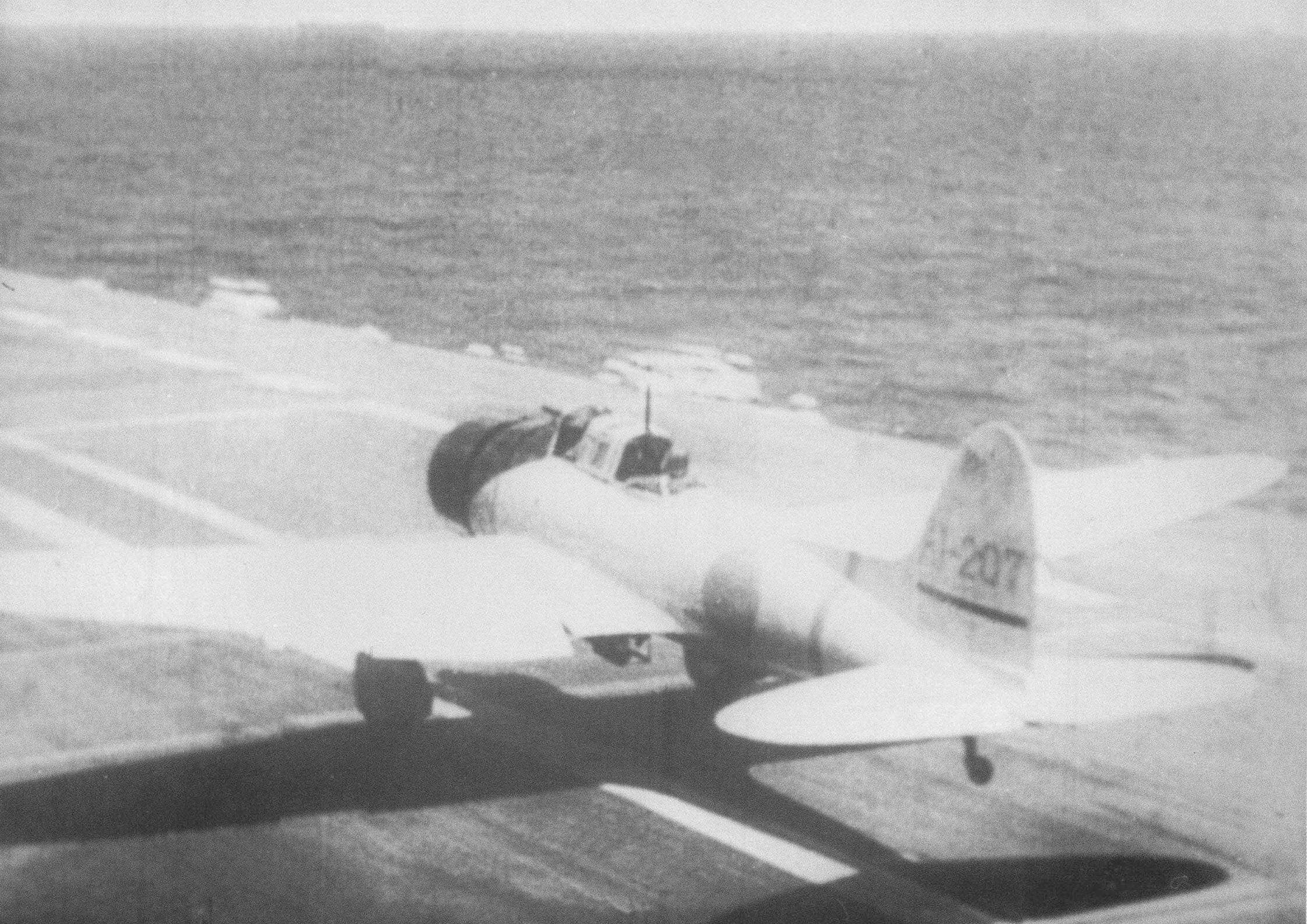
| Historical Information | ||||||||||||
| Caption | D3A dive bomber taking off from carrier Akagi, Indian Ocean, 5 Apr 1942; the single vertical red stripe toward the rear end of fuselage identified this aircraft as from Akagi ww2dbase | |||||||||||
| WW2-Era Location Name | Indian Ocean | |||||||||||
| Date | 5 Apr 1942 | |||||||||||
| Photographer | Unknown | |||||||||||
| Source Information | ||||||||||||
| Source | ww2dbaseWikimedia Commons | |||||||||||
| Link to Source | Link | |||||||||||
| Related Content | ||||||||||||
| More on... |
| |||||||||||
| Photos on Same Day | 5 Apr 1942 | |||||||||||
| Licensing Information | ||||||||||||
| Licensing | This work originating in Japan is in the public domain. According to Article 23 of the 1899 Copyright Act of Japan and Article 2 of Supplemental Provisions of Copyright Act of 1970, a work is in the public domain if it was created or published before 1 Jan 1957. Please contact us regarding any inaccuracies with the above information. Thank you. |
|||||||||||
| Metadata | ||||||||||||
| Added By | C. Peter Chen | |||||||||||
| Photo Size | 2,242 x 1,585 pixels | |||||||||||
Você gostou deste artigo ou achou este artigo útil? Se sim, considere nos apoiar no Patreon. Mesmo USD $1 por mês já vai longe! Obrigado. Por favor, ajude-nos a espalhar a palavra: Fique atualizado com WW2DB: |
Visitor Submitted Comments
2.  Bill says:
Bill says:
16 Oct 2016 07:38:32 PM
INTO THE WIND:
When launching aircraft, the carriers had the A6M Zeros/Zeke's off first, followed by D3A Val's and last the B5N Kate bombers.
Photo shows Aichi D3A "Val" AI-207 flown by Petty Officer 1st class (PO1c) Yoshiharu Tanaka pilot and Lt (jg) Keizo Obuchi radio/gunner.
16 Oct 2016 07:38:32 PM
INTO THE WIND:
When launching aircraft, the carriers had the A6M Zeros/Zeke's off first, followed by D3A Val's and last the B5N Kate bombers.
Photo shows Aichi D3A "Val" AI-207 flown by Petty Officer 1st class (PO1c) Yoshiharu Tanaka pilot and Lt (jg) Keizo Obuchi radio/gunner.
All visitor submitted comments are opinions of those making the submissions and do not reflect views of WW2DB.
Pesquisar WW2DB

Notícias
- » Köln/Cologne Evacuated After Discovery of WW2 Bombs (4 Jun 2025)
- » US Women's Army Corps "Six Triple Eight" Awarded with Congressional Gold Medal (30 Apr 2025)
- » Wreck of Soviet Submarine M-49 Found (10 Apr 2025)
- » Japanese Emperor Visited Iwoto (Iwo Jima) (8 Apr 2025)
- » Race, Holocaust, and African-American WW2 Histories Removed from the US Naval Academy Library (7 Apr 2025)
- » US Government Plans to Purge WW2 Information (17 Mar 2025)
- » Ver todas as notícias
Estatísticas Atuais do Site
- » 1,171 biographies
- » 337 events
- » 44,911 timeline entries
- » 1,245 ships
- » 350 aircraft models
- » 207 vehicle models
- » 376 weapon models
- » 123 historical documents
- » 261 facilities
- » 470 book reviews
- » 28,521 photos
- » 365 maps
Citação Famosa da 2ª GM
"We no longer demand anything, we want war."Joachim von Ribbentrop, German Foreign Minister, Aug 1939
Apoie-nos
Por favor, considere nos apoiar no Patreon. Mesmo R$1 por mês já faz uma grande diferença. Obrigado!
Ou, por favor, nos apoie adquirindo alguns produtos do WW2DB na TeeSpring. Obrigado!
29 Jun 2015 11:55:08 AM
FLIGHT OPERATIONS:
Aichi D3A, Type 99 Dive Bomber AI-207 flown by Petty Officer 1st Cass (PO1/c) Yoshiharu Tanaka, Lieutenant (JG) Junior Grade Keizo Obuchi back seat Radio/Gunner launched from carrier Akagi
HAZARDOUS DUTY:
Both American and Japanese pilots faced the same hazards, during the first six months of the Pacific war crews fought over vast areas of ocean
Carrier warfare over the vast ocean was a back and forth action, with gains and losses to both sides.
LOST:
Pilots flew over water with limited navigational aids, faced changing weather, mechanical failure
even if they met and attacked the enemy, they still faced battle damage, fuel loss or wounds,
in the heat of battle aircraft became separated or lost due to radio failure.
Aircraft and crews were lost before contact with the enemy due to factors listed above. Reports of enemy ships that turned out to be inaccurate
launching from their carrier location, that within a few hours wouldn't be there the ship moving on to another position. Many of these brave men just disappeared without a trace.